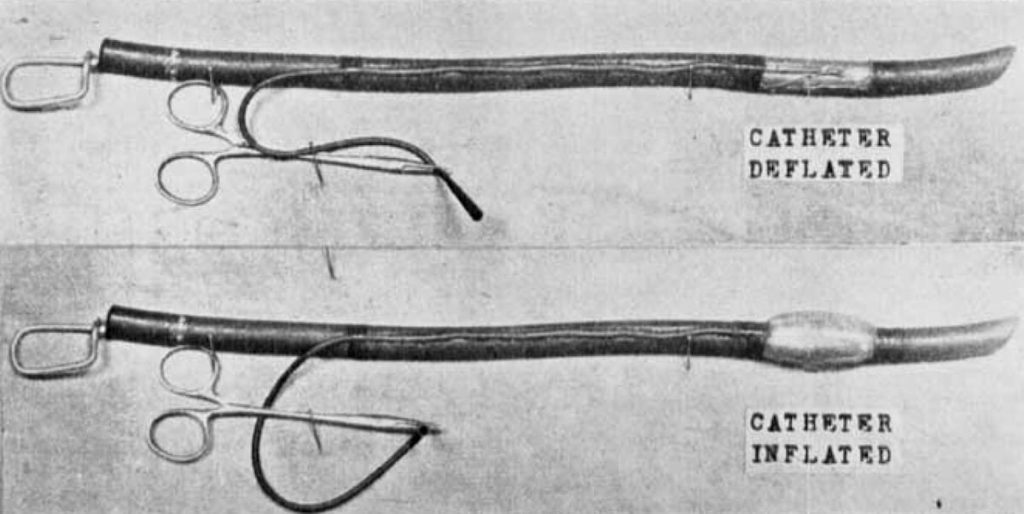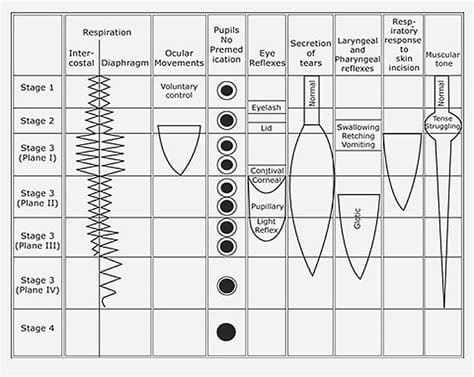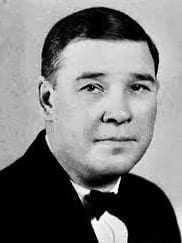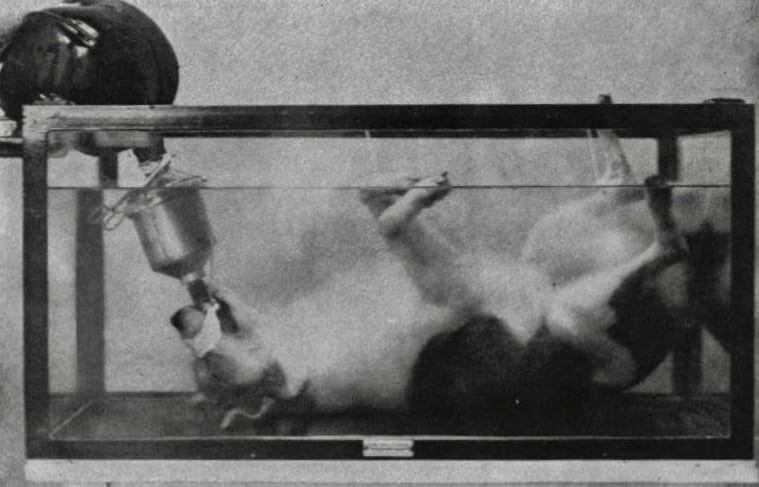Arthur Ernest Guedel
Arthur Ernest Guedel (1883 – 1956) was an American anesthesiologist.
Guedel served during the First World War. During this time there were a high number of men requiring surgery, he therefore developed a training school to teach orderlies and nurses to administer ester anaesthesia. He created a chart to demonstrate the stages and help his trainees assess the depth of anaesthesia, this chart was used worldwide for more than fifty years.
In 1933 Guedel designed a rubber pharyngeal airway with a metal insert to prevent occlusion if bitten. The ‘Guedel airway‘ has stood the test of time for nearly 90 years. Guedel also developed the first inflatable cuffs for endotracheal tubes from the fingers of rubber gloves, in the basement of his home.
Guedel’s research background, combined with experience during peace and war, was the basis for: Inhalation anesthesia – A fundamental guide, first published in 1937
Biography
- Born on June 13, 1883 in Cambridge City, Indiana.
- 1896 – Lost three fingers from his right hand aged 13, but despite this he went onto become an accomplished pianist, organist and composer.
- 1903-1908 – Attended The Medical College of Indiana.
- 1908 – Following graduation interned at City Hospital, Indianapolis.
- 1909 – Opened his first general practice. To supplement his income he provided anaesthetic services to hospitals and dental offices.
- 1914-1918 – Anaesthetist in the American Expeditionary Forces in France; known as the “motorcycle anesthetist“.
- 1928 – Clinical professor of anaesthesia, University of Southern California.
- 1933 – Guedel Oral Airway design published in Journal of the American Medical Association.
- 1937 – Published: Inhalation Anaesthesia, a Fundamental Guide.
- 1941 – Henry Hill Hickman Medal, Royal Society of Medicine; first recipient from outside the British Isles
- 1950 – Distinguished Service Award of the American Society of Anaesthesiologists
- 1951 – Produced a second edition of Inhalation Anaesthesia, a Fundamental Guide
- Died on June 10, 1956.
Medical Eponyms
Guedel-Waters Cuffed intratracheal tube (1928)

The catheter effectively prevents all air leaks and renders the respiratory system entirely closed, with a controllable to and fro respiratory exchange. Aspiration of foreign matter into the lungs is not possible with the catheter in place.
Guedel 1928
Guedel Oropharyngeal airway (1933)
In 1933 Guedel designed a metal pharyngeal airway moulded in rubber to prevent occlusion by biting. The ‘Guedel’ airway has stood the test of time for nearly 80 years.
Original description of the Guedel oropharyngeal airway
Guedel laryngeal plug (1934)
The laryngeal plug is a little-known device developed by Arthur E. Guedel in the 1930s. The device was an alternative to the inflatable cuff used on tracheal tubes. Guedel did not publish a description of the laryngeal plug and the most detailed description was published by Gilbert Reynolds Troup (1896-1962), an Australian anaesthetist.
This plug of Guedel is made of soft rubber; it fits round the catheter like the inflatable cuff and serves the same purpose. Guedel claims the catheter plus plug is easier to introduce into the trachea than the cuffed catheter…It causes less irritation than the inflatable cuff, the nidus of which is lower in the trachea…
Troup 1935
Guedel classification (1937)
The first classification system for general anaesthesia was proposed in 1847 by John Snow (1813-1858) as the 5 stages of etherization (narcotism); and furthered by Francis Plomley in the Lancet in the same year. Guedel proposed a four stage classification system to assess the depth of general anesthesia in 1937. This was designed for use with a single inhalational anesthetic agent (ether), in patients premedicated with morphine and atropine.

- Stage 1: Analgesia and amnesia. From induction of general anesthesia to loss of consciousness
- Stage 2: Delirium and unconsciousness. From loss of consciousness to onset of automatic breathing
- Stage 3: Surgical anesthesia. From automatic respiration to respiratory paralysis. (four planes of depth)
- Stage 4: From apnoea (stoppage of breathing) to death.
In 1954, JF Artusio further divided stage 1 into an additional three planes of depth
Other Eponyms
Artur E. Guedel Memorial Anesthesia Center, San Francisco – Opened 1964. This has a library of current and historical writings.
Controversies
Guedel developed and overcame addictions to barbiturates and amphetamines to control his insomnia. He would later educate physicians regarding the risks of addiction.
Guedel performed the ‘dunked dog’ experiment. He anaesthetised, intubated and immersed his own dog (nicknamed ‘Airway‘) at the beginning of a lecture he was giving to prove his inflatable cuff for an endotracheal tube effective. Following the demonstration, he revived the dog, allowed him to waken, shake-off and exit the theatre to the applause of the audience.
Major Publications
- Guedel AE. Nitrous oxide air anesthesia self-administered in obstetrics – a preliminary report. Indianapolis Medical Journal. 1911; 14: 476–479.
- Guedel AE. Auscultatory control of vapor anesthesia. Am J Surg 1919; 33: 24–26
- Guedel AE. Third stage ether anaesthesia: a sub-classification regarding the significance of the position and movements of the eyeball. Am. J. Surg. (Anesth Suppl.). 1920; 34: 53–57.
- Guedel AE, Waters RM. A new intratracheal catheter. Anesth Analg 1928; 7: 238-239
- Guedel AE. A nontraumatic pharyngeal airway. JAMA 1933; 100(23): 1862 [Guedel Airway]
- Waters RM, Rovenstine AE, Guedel AE. Endotracheal anesthesia and its historical development. Current Researches in Anesthesia & Analgesia 1933; 12(5): 196–203
- Guedel AE. Inhalation anesthesia – A fundamental guide. Macmillan. 1937 [Guedel Classification]
- Guedel AE. Cyclopropane anesthesia. Anesthesiology 1940;1:13–25
References
Biography
- Waters R. Eminent anaesthetists, No. 7: Arthur E. Guedel. Br J Anaesth 1952; 24: 292-299.
- Baskett TF. Arthur Guedel and the oropharyngeal airway. Resuscitation. 2004 Oct;63(1):3-5.
- Calmes SH. Two Men and their dog: Ralph Waters, Arthur Guedel, and the dunked dog “Airway”. 2004: 37-41
- Maltby R. Notable Names in Anaesthesia. The Choir Press. 2013: 84-86
- Calverley RK. Arthur E. Guedel (1883–1956) In: Rupreht J, van Lieburg M.J, Lee J.A, Erdmann W. (eds) Anaesthesia. Springer, Berlin, Heidelberg
- Drew BA. Arthur Guedel and the Ascendance of Anesthesia: a Teacher, Tinkerer, and Transformer. Journal of Anesthesia History. 2018
- Bibliography. Guedel, Arthur E. WorldCat Identities
Eponymous terms
- Snow J. On the Inhalation of the Vapour of Ether in surgical operations; containing a description of the various stages of etherization, and a statement of the result of nearly eighty operations. 1847
- Plomley F. Operations upon the eye. Lancet. 1847; 49(1222): 134-135
- Troup G. Anaesthesia in America. Medical Journal of Australia 1935; 2: 857-863
- Troup G. Anesthesia in Australia. Anesth Analg 1935; 14(6): 249-252.
- Artusio JF Jr. Di-ethyl ether analgesia: a detailed description of the first stage of ether anesthesia in man. J Pharmacol Exp Ther. 1954 Jul;111(3):343-8.
- Calmes SH. Dr Arthur Guedel’s Contributions. American Society of Anaesthethiologists. 2008;72(9):14-17
- Haridas RP, Nichols TT. Arthur Guedel’s laryngeal plug. Anaesth Intensive Care. 2013 Jul;41 Suppl 1:16-8.
- McKennedy C. Guedel airway – Eponym A Day. Instagram
[cite]
British doctor, working in Perth. Studied at Leeds University, graduated with an MBChB and BSc in Microbiology. Interests include netball and critical care.





